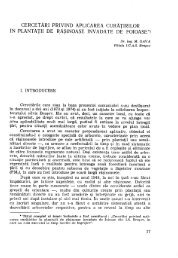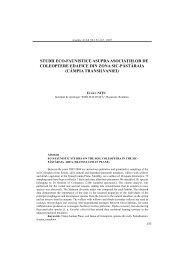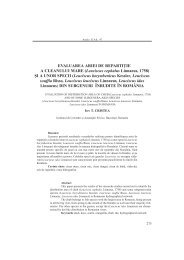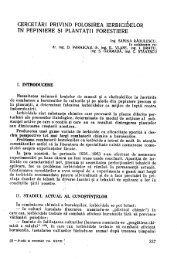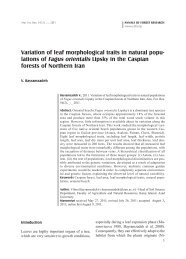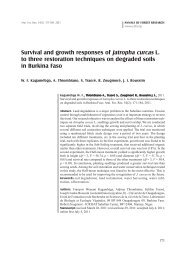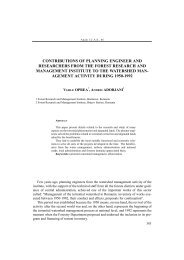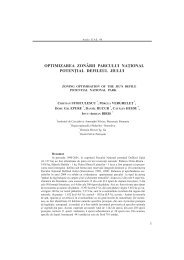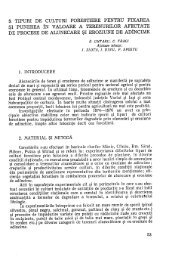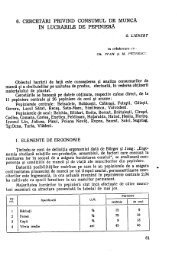Romania (Quercus cerris, Q. frainetto, Q. robur) and - EdituraSilvica.ro
Romania (Quercus cerris, Q. frainetto, Q. robur) and - EdituraSilvica.ro
Romania (Quercus cerris, Q. frainetto, Q. robur) and - EdituraSilvica.ro
Create successful ePaper yourself
Turn your PDF publications into a flip-book with our unique Google optimized e-Paper software.
Fodor et al. Mycorrhizal status of several <st<strong>ro</strong>ng>Quercus</st<strong>ro</strong>ng> species in <st<strong>ro</strong>ng>Romania</st<strong>ro</strong>ng> ...in seedling mycorrhizae as well as in maturetrees’ <strong>ro</strong>ots (Piggott 1982, Kranabetter &Wylie 1998) associating with 122 host species(Trappe 1964). The outer layer of the mantleconsists of thick walled cells, resembling thegelatinous walls of many lichenicolous fungi.When wet, these walls become gelatinous,p<strong>ro</strong>viding an envi<strong>ro</strong>nment for water storage,which is of capital importance during thed<strong>ro</strong>ught episodes. This pecularity gives an advantageto seedlings possessing C. geophilummycorrhiza (Piggot 1982). Being ubiquitous bynature, C. geophilum links plants in a commonmycorrhizal network (Valentine at al. 2004). Itis an early stage <st<strong>ro</strong>ng>and</st<strong>ro</strong>ng> also a late stage associatein seral succession of the forests. Late stagefungi, such as Lactarius spp. <st<strong>ro</strong>ng>and</st<strong>ro</strong>ng> Russula spp.are infrequent on <strong>ro</strong>ots <st<strong>ro</strong>ng>and</st<strong>ro</strong>ng> the inoculationp<strong>ro</strong>duces via <strong>ro</strong>ot connections, rather than bymycelial fragments or spores as in early stagemycorrhiza (Jones et al. 1998).The association of different morphotypes ismore or less r<st<strong>ro</strong>ng>and</st<strong>ro</strong>ng>om, with respect to closelyrelated hosts in the same location <st<strong>ro</strong>ng>and</st<strong>ro</strong>ng> showrelatively high similarity between locationsrelated to the same host species. Still the nullhypothesis of r<st<strong>ro</strong>ng>and</st<strong>ro</strong>ng>om association is to be carefullyveried on larger sets of data. The generaltrend is a variation of morphotypes, accordingto geographical factors (Southern versusNorth-Western <st<strong>ro</strong>ng>Romania</st<strong>ro</strong>ng>) <st<strong>ro</strong>ng>and</st<strong>ro</strong>ng> also to relatedhosts allocation (<st<strong>ro</strong>ng>Quercus</st<strong>ro</strong>ng> spp.). There is anevidence of within site partition of the samemorphotypes among <st<strong>ro</strong>ng>Quercus</st<strong>ro</strong>ng> hosts <st<strong>ro</strong>ng>and</st<strong>ro</strong>ng> similarityof sites f<strong>ro</strong>m same geographical area. Itis worth to mention the dissimilarity in morphotypeallocation in Q. <st<strong>ro</strong>ng><strong>ro</strong>bur</st<strong>ro</strong>ng> as compared toQ. <st<strong>ro</strong>ng>cerris</st<strong>ro</strong>ng> <st<strong>ro</strong>ng>and</st<strong>ro</strong>ng> Q. <st<strong>ro</strong>ng>frainetto</st<strong>ro</strong>ng>.Stressful conditions affect trees in urban areas,a fact reected in their mycorrhizal status,<st<strong>ro</strong>ng>and</st<strong>ro</strong>ng> in lower frequency of mycorrhizal apices.Also, carpophore p<strong>ro</strong>duction is a seldom eventin urban areas (Danielson & Pruden 1989, Baxteret al. 1999) never observed in present survey(f<strong>ro</strong>m 1997 to 2008) in the city of Oradea.D<strong>ro</strong>ught <st<strong>ro</strong>ng>and</st<strong>ro</strong>ng> oil pollution reported f<strong>ro</strong>m Tincainuenced the mycorrhizal status of Q. <st<strong>ro</strong>ng>cerris</st<strong>ro</strong>ng><st<strong>ro</strong>ng>and</st<strong>ro</strong>ng> Q. <st<strong>ro</strong>ng>frainetto</st<strong>ro</strong>ng>, reected in low frequenciesof mycorrhizal apices.Modern investigations on the diversity ofmycorrhiza, associated with a particular treehost, rely on DNA nger-printing. This diversityassessment takes into account all potentialmycobionts associated with a tree <st<strong>ro</strong>ng>and</st<strong>ro</strong>ng> notthose active at a particular moment. For activemycorrhiza at a time snapshot, the classical assessmentbased on morphotypes is a better app<strong>ro</strong>achon our opinion based on the presentedresults.These results lead to the idea that articialinoculation with site-adapted mycobiontswould enhance plant g<strong>ro</strong>wth <st<strong>ro</strong>ng>and</st<strong>ro</strong>ng> survival afte<strong>ro</strong>utplanting, an opinion shared with otherauthors (e.g. Gerhardt et al. 2007). The mycorrhizationis induced either under laboratoryconditions on dual host-fungus systems, eitherduring the seedlings g<strong>ro</strong>wth by inoculation ofthe fungal inoculum in nursery containers, theinoculum being represented by spores, myceliaor simply, fragments of app<strong>ro</strong>priate carpophores(Martinez-Amores et al. 1991). The mic<strong>ro</strong>p<strong>ro</strong>pagatedplantlets of <st<strong>ro</strong>ng>Quercus</st<strong>ro</strong>ng> species canbe exposed to mycobionts in order to inducemycorrhization. In our opinion, a good c<st<strong>ro</strong>ng>and</st<strong>ro</strong>ng>idateis Cenococcum geophilum, due to its largeecological <st<strong>ro</strong>ng>and</st<strong>ro</strong>ng> host range, <st<strong>ro</strong>ng>and</st<strong>ro</strong>ng> the capacity toinduce frequent mycorrhizal tips, a hypothesisworth to test under experimental conditions.As a consequence, it is a good c<st<strong>ro</strong>ng>and</st<strong>ro</strong>ng>idate formycorrhization in dual systems (oak mic<strong>ro</strong>cuttingsor mic<strong>ro</strong>p<strong>ro</strong>pagated plants + mycobiont)in Petri dishes, a similar app<strong>ro</strong>ach being p<strong>ro</strong>posedby Herrmann et al. (1998).ConclusionThe investigation of mycorrhizae using theclassical app<strong>ro</strong>ach of morphotype descriptionyielded 30 types common for <st<strong>ro</strong>ng>Quercus</st<strong>ro</strong>ng> <st<strong>ro</strong>ng><strong>ro</strong>bur</st<strong>ro</strong>ng>,Q. <st<strong>ro</strong>ng>cerris</st<strong>ro</strong>ng>, Q. <st<strong>ro</strong>ng>frainetto</st<strong>ro</strong>ng>. The original descriptionsof the morphotypes p<strong>ro</strong>vide a recognition69



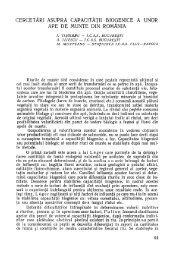
![studiu privind conditiilb] de vegetatie ale ... - EdituraSilvica.ro](https://img.yumpu.com/50877313/1/175x260/studiu-privind-conditiilb-de-vegetatie-ale-editurasilvicaro.jpg?quality=85)

